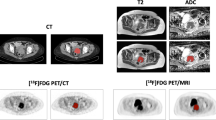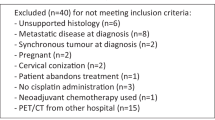Abstract
Background
In this study, we investigated the correlation between the lymph node (LN) status or histological types and textural features of cervical cancers on 18F-fluorodeoxyglucose positron emission tomography/computed tomography.
Methods
We retrospectively reviewed the imaging records of 170 patients with International Federation of Gynecology and Obstetrics stage IB–IVA cervical cancer. Four groups of textural features were studied in addition to the maximum standardized uptake value (SUVmax), metabolic tumor volume, and total lesion glycolysis (TLG). Moreover, we studied the associations between the indices and clinical parameters, including the LN status, clinical stage, and histology. Receiver operating characteristic curves were constructed to evaluate the optimal predictive performance among the various textural indices. Quantitative differences were determined using the Mann–Whitney U test. Multivariate logistic regression analysis was performed to determine the independent factors, among all the variables, for predicting LN metastasis.
Results
Among all the significant indices related to pelvic LN metastasis, homogeneity derived from the gray-level co-occurrence matrix (GLCM) was the sole independent predictor. By combining SUVmax, the risk of pelvic LN metastasis can be scored accordingly. The TLGmean was the independent feature of positive para-aortic LNs. Quantitative differences between squamous and nonsquamous histology can be determined using short-zone emphasis (SZE) from the gray-level size zone matrix (GLSZM).
Conclusion
This study revealed that in patients with cervical cancer, pelvic or para-aortic LN metastases can be predicted by using textural feature of homogeneity from the GLCM and TLGmean, respectively. SZE from the GLSZM is the sole feature associated with quantitative differences between squamous and nonsquamous histology.




Similar content being viewed by others
Abbreviations
- PET/CT:
-
Positron emission tomography/computed tomography
- SUVmax :
-
maximum standardized uptake value
- TLG:
-
total lesion glycolysis
- MTV:
-
metastatic tumor volume
- SZE:
-
short-zone emphasis
References
Hanahan D, Weinberg RA. Hallmarks of cancer: the next generation. Cell. 2011;144:646–74.
Asselin MC, O’Connor JP, Boellaard R, Thacker NA, Jackson A. Quantifying heterogeneity in human tumors using MRI and PET. Eur J Cancer. 2012;48:447–55.
Chicklore S, Goh V, Siddique M, Roy A, Marsden PK, Cook GJ. Quantifying tumor heterogeneity in 18 F-FDG PET/CT imaging by texture analysis. Eur J Nucl Med Mol Imaging. 2013;40:133–40.
Tixier F, Le Rest CC, Hatt M, et al. Intratumor heterogeneity characterized by textural features on baseline 18F-FDG PET images predicts response to concomitant radiochemotherapy in esophageal cancer. J Nucl Med. 2011;52:369–78.
Vaidya M, Creach KM, Frye J, Dehdashti F, Bradley JD, El Naqa I. Combined PET/CT image characteristics for radiotherapy tumor response in lung cancer. Radiother Oncol. 2012;102:239–45.
Cook GJR, Yip C, Siddique M, et al. Are pretreatment 18F-FDG PET tumor textural features in non-small cell lung cancer associated with response and survival after chemoradiotherapy? J Nucl Med. 2013;54:19–26.
Hatt M, Majdoub M, Vallieres M, et al. 18F-FDG PET uptake characterization through texture analysis: investigating the complementary nature of heterogeneity and functional tumor volume in a multi-cancer site patient cohort. J Nucl Med. 2015;56:38–44.
Ohri N, Duan F, Snyder BS, et al. Pretreatment 18FDG-PET textural features in locally advanced non-small cell lung cancer: secondary analysis of ACRIN 6668/RTOG 0235. J Nucl Med. 2016.
Kidd EA, Grigsby PW. Intratumoral metabolic heterogeneity of cervical cancer. Clin Cancer Res. 2008;14:5236–524.
Yang F, Thomas MA, Dehdashti F, Grigsby PW. Temporal analysis of intratumoral metabolic heterogeneity characterized by textural features in cervical cancer. Eur J Nucl Med Mol Imaging. 2013;40:716–27.
Ho KC, Fang YH, Chung HW, et al. A preliminary investigation into textural features of intratumoral metabolic heterogeneity in FDG PET for overall survival prognosis in patients with bulky cervical cancer treated with definitive concurrent chemoradiotherapy. Am J Nucl Med Mol Imaging. 2016;6:166–75.
Cheng NM, Fang YH, Lee LY, et al. Zone-size nonuniformity of 18F-FDG PET regional textural features predicts survival in patients with oropharyngeal cancer. Eur J Nucl Med Mol Imaging. 2015;42:419–28.
Orlhac F, Soussan M, Maisonobe JA, Garcia CA, Vanderlinden B, Buvat I. Tumor texture analysis in 18F-FDG PET: relationships between texture parameters, histogram indices, standardized uptake values, metabolic volumes, and total lesion glycolysis. J Nucl Med. 2014;55:414–22.
Stehman FB, Bundy BN, DiSaia PJ, Keys HM, Larson JE, Fowler WC. Carcinoma of the cervix treated with radiation therapy. I. A multi-variate analysis of prognostic variables in the gynecologic oncology group. Cancer. 1991;67:2776–85.
Kidd EA, Siegel BA, Dehdashti F, et al. Lymph node staging by positron emission tomography in cervical cancer: relationship to prognosis. J Clin Oncol. 2010;28:2108–13.
Yen TC, Ng KK, Ma SY, et al. Value of dual-phase 2-fluoro-2-deoxy-d-glucose positron emission tomography in cervical cancer. J Clin Oncol. 2003;21:3651–8.
Reinhardt MJ, Ehritt-Braun C, Vogelgesang, et al. Metastatic lymph nodes in patients with cervical cancer: detection with MR imaging and FDG PET. Radiology. 2001;218:776–82.
Chen SW, Hsieh TC, Yen KY, Liang JA, Kao CH. Pretreatment 18F-FDG PET/CT in whole body total lesion glycolysis to predict survival in patients with pharyngeal cancer treated with definitive radiotherapy. Clin Nucl Med. 2014;39:e296–300.
Meyer F. Topographic distance and watershed lines. Signal Processing. 1994;38:113–25.
Haralick RM, Shanmugam K, Dinstein I. Textural features for image classification. IEEE Trans Syst Man Cybern. 1973;3:610–21.
Sun C, Wee WG. Neighboring gray level dependence matrix for texture classification. Comput Vis Graph Image Process. 1983;23:341–52.
Loh H, Leu J, Luo R. The analysis of natural textures using run length features. IEEE Trans Ind Electron. 1988;35:323–8.
Thibault G, Fertil B, Navarro C, et al. Texture indexes and gray level size zone matrix: application to cell nuclei classification. Pattern Recognit Inf Process. 2009;140–145.
Brooks FJ, Grigsby PW. FDG uptake heterogeneity in FIGO IIb cervical carcinoma does not predict pelvic lymph node involvement. Radiat Oncol. 2013;23(8):294.
van Velden FH, Kramer GM, Frings V, Nissen IA, Mulder ER, de Langen AJ, Hoekstra OS, Smit EF, Boellaard R. Repeatability of Radiomic Features in Non-Small-Cell Lung Cancer [(18)F]FDG-PET/CT Studies: Impact of Reconstruction and Delineation. Mol Imaging Biol. 2016;18:788–95.
Leijenaar RT, Nalbantov G, Carvalho S, van Elmpt WJ, Troost EG, Boellaard R, Aerts HJ, Gillies RJ, Lambin P. The effect of SUV discretization in quantitative FDG-PET Radiomics: the need for standardized methodology in tumor texture analysis. Sci Rep. 2015;5:11075.
Desseroit MC, Tixier F, Weber WA, Siegel BA, Cheze Le Rest C, Visvikis D, Hatt M. Reliability of PET/CT shape and heterogeneity features in functional and morphological components of Non-Small Cell Lung Cancer tumors: a repeatability analysis in a prospective multi-center cohort. J Nucl Med. 2016; doi:10.2967/jnumed.116.180919.
Tixier F, Hatt M, Le Rest CC, Le Pogam A, Corcos L, Visvikis D. Reproducibility of tumor uptake heterogeneity characterization through textural feature analysis in 18F-FDG PET. J Nucl Med. 2012;53:693–700.
Leijenaar RT, Carvalho S, Velazquez ER, van Elmpt WJ, Parmar C, Hoekstra OS, Hoekstra CJ, Boellaard R, Dekker AL, Gillies RJ, Aerts HJ, Lambin P. Stability of FDG-PET Radiomics features: an integrated analysis of test-retest and inter-observer variability. Acta Oncol. 2013;52:1391–7.
Hatt M, Tixier F, Pierce L, Kinahan PE, Le Rest CC, Visvikis D. Characterization of PET/CT images using texture analysis: the past, the present… any future? Eur J Nucl Med Mol Imaging. 2017;44:151–65.
Contag SA, Gostout BS, Clayton AC, Dixon MH, McGovern RM, Calhoun ES. Comparison of gene expression in squamous cell carcinoma and adenocarcinoma of the uterine cervix. Gynecol Oncol. 2004;95:610–7.
Fujimoto T, Nishikawa A, Iwasaki M, Akutagawa N, Teramoto M, Kudo R. Gene expression profiling in two morphologically different uterine cervical carcinoma cell lines derived from a single donor using a human cancer cDNA array. Gynecol Oncol. 2004;93:446–53.
Hatt M, Lee J, Schmidtlein CR, El Naqa I, Caldwell C, De Bernardi E, et al. Classification and evaluation strategies of auto-segmentation approaches for PET: Report of AAPM Task Group No. 211. Med Phys. 2017 Jan 24; doi:10.1002/mp.12124.
Acknowledgements
This study was supported in part by the Taiwan Ministry of Health and Welfare Clinical Trial and Research Center of Excellence (MOHW106-TDU-B-212-113004); China Medical University Hospital, Academia Sinica Taiwan Biobank Stroke Biosignature Project (BM10501010037); NRPB Stroke Clinical Trial Consortium (MOST105-2325-B-039-003); Tseng-Lien Lin Foundation (Taichung, Taiwan); Taiwan Brain Disease Foundation (Taipei, Taiwan); Katsuzo and Kiyo Aoshima Memorial Funds, Japan; Taiwan Ministry of Science and Technology (MOST 105-2218-E-009-034); and Asia University, Taichung, Taiwan (ASIA-105-CMUH-14); and Welfare Surcharge of Tobacco Products, China Medical University Hospital Cancer Research Center of Excellence (MOHW105-TDU-B-212-134-003, Taiwan). The funders played no role in the study design, data collection and analysis, publication decision, or manuscript drafting. No additional external funding was received for this study.
Author information
Authors and Affiliations
Contributions
WC Shen, SW Chen, and CH Kao were responsible for design of the study. All authors collected the data. SW Chen, WC Shen, and CH Kao carried out statistical analysis, interpretation of data, and drafting the article. All authors provided some intellectual content. SW Chen, WC Shen, and CH Kao approved the version to be submitted. All authors read and approved the final manuscript. SW Chen and WC Shen are equally contributory to this article.
Corresponding author
Ethics declarations
Conflict of interest
All authors declare no conflicts of interest.
Ethical approval
This study was approved by a local institutional review board DMR99-IRB-010(CR6).
Informed consent
The institutional review board specifically waived the consent requirement.
Electronic supplementary material
Appendix 1.
Indices calculated from the textural analysis. The performance of a texture index in predicting the PLN metastasis was evaluated by the area under the ROC curve. To evaluate the performance of a discretization method, the average and standard deviation of all areas of each texture index acquired from all parameters of the discretization method were calculated. (DOCX 18 kb)
Appendix 2.
Textural indices that showed a varying trend between patients with FIGO stages I and II and III–IVA. (DOCX 18 kb)
Appendix 3.
According to pelvic lymph node (PLN) metastasis, (a) the scatterplot of the MTV and homogeneity and (b) that of the TLGmean and homogeneity of the primary tumors. The largest tumor with an MTV of 449.962.3 mm3 with PLN metastasis was excluded from the scatterplot (a), as detailed on the y-axis. (DOCX 3742 kb)
ESM 1
(XLSX 19 kb)
Rights and permissions
About this article
Cite this article
Shen, WC., Chen, SW., Liang, JA. et al. [18]Fluorodeoxyglucose Positron Emission Tomography for the Textural Features of Cervical Cancer Associated with Lymph Node Metastasis and Histological Type. Eur J Nucl Med Mol Imaging 44, 1721–1731 (2017). https://doi.org/10.1007/s00259-017-3697-1
Received:
Accepted:
Published:
Issue Date:
DOI: https://doi.org/10.1007/s00259-017-3697-1




